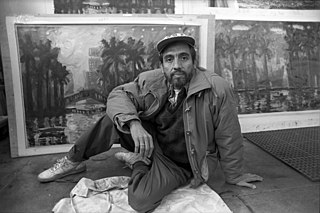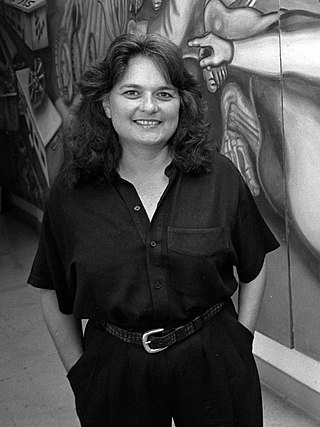Related Research Articles

Graffiti is art that is written, painted or drawn on a wall or other surface, usually without permission and within public view. Graffiti ranges from simple written words to elaborate wall paintings, and has existed since ancient times, with examples dating back to ancient Egypt, ancient Greece, and the Roman Empire.

A mural is any piece of graphic artwork that is painted or applied directly to a wall, ceiling or other permanent substrate. Mural techniques include fresco, mosaic, graffiti and marouflage.

Diego María de la Concepción Juan Nepomuceno Estanislao de la Rivera y Barrientos Acosta y Rodríguez, known as Diego Rivera, was a prominent Mexican painter. His large frescoes helped establish the mural movement in Mexican and international art.

Banksy is a pseudonymous England-based street artist, political activist and film director whose real name and identity remain unconfirmed and the subject of speculation. Active since the 1990s, his satirical street art and subversive epigrams combine dark humour with graffiti executed in a distinctive stenciling technique. His works of political and social commentary have appeared on streets, walls and bridges throughout the world. Banksy's work grew out of the Bristol underground scene, which involved collaborations between artists and musicians. Banksy says that he was inspired by 3D, a graffiti artist and founding member of the musical group Massive Attack.

Oak Cliff is a neighborhood of Dallas, Texas, that was formerly a separate town in Dallas County; Dallas annexed Oak Cliff in 1901. It has since retained a distinct neighborhood identity as one of Dallas' older established neighborhoods.

Street art is visual art created in public locations for public visibility. It has been associated with the terms "independent art", "post-graffiti", "neo-graffiti" and guerrilla art.

Carlos D. Almaraz was a Mexican-American artist and a pioneer of the Chicano art movement.
This article is about the culture of Dallas, Texas (USA).

Judith Francisca Baca is an American artist, activist, and professor of Chicano studies, world arts, and cultures based at the University of California, Los Angeles. She is the co-founder and artistic director of the Social and Public Art Resource Center (SPARC) in Venice, California. Baca is the director of the mural project that created the Great Wall of Los Angeles, which is the largest communal mural project in the world.

Crash is a graffiti artist.

Oxtotitlán is a natural rock shelter and archaeological site in Chilapa de Álvarez, Mexican state of Guerrero that contains murals linked to the Olmec motifs and iconography. Along with the nearby Juxtlahuaca cave, the Oxtotitlán rock paintings represent the "earliest sophisticated painted art known in Mesoamerica", thus far. Unlike Juxtlahuaca, however, the Oxtotitlán paintings are not deep in a cave system but rather occupy two shallow grottos on a cliff face.

Since the 1980s, the area surrounding the Sydney inner west suburb of Newtown, New South Wales (NSW), Australia—including the suburbs of Newtown, Enmore, Erskineville, Camperdown and St Peters—has been known for its wide range of prominent graffiti and street art on walls. The public visual art in the Newtown area consists of a variety of styles and methods of execution, including large-scale painted murals, hand-painted political slogans, hand-painted figurative designs, spray painted semi-abstract designs "tags"), and other stylistic developments such as stencil art and street poster art, "Yarn bombing", and sculptural items cast from plaster and other materials.
Graffiti in Iran consists of different styles. Some are slogans painted by governmental organizations, and some are works of art by regular citizens. During the last few years, Tehran Municipality has been drawing graffiti in order to beautify the city. Much governmental graffiti regards the Iranian Revolution, Islamic Republic of Iran policies and The Politics of Resistance. Pro-democracy activists are also continuing a political graffiti campaign in Tehran. Islamic graffiti can also be seen around the city. Graffiti has long served as a medium of expression through Iran's complicated political history.

The Chicano Art Movement represents groundbreaking movements by Mexican-American artists to establish a unique artistic identity in the United States. Much of the art and the artists creating Chicano Art were heavily influenced by Chicano Movement which began in the 1960s.
Daniel Manrique was a Mexican artist whose life and work mostly revolved around his home neighborhood of Tepito in Mexico City. He was born into a poor family, who did not support his artistic ambitions, but he maintained his Tepito identity despite. Manrique is best known for his mural work, which depicts the life and popular culture of poor urban neighborhoods such as Tepito, as well as aspects of Mexican and Latin American history since the Spanish conquest. Most of this work was done in Tepito as part of the program he founded called Tepito Arte Acá, but he also did murals in other countries such as Canada and Argentina. His work and the work of Tepito Arte Acá has been recognized by UNESCO, several universities, the Museo de Arte Moderno, CONACULTA, INBA and he was accepted into the Salón de la Plástica Mexicana.

In Hong Kong there are a few types of graffiti that are utilized for different reasons. The face of artist Ai Weiwei is one of the more well-known caricatures in the region. Journalist and commentators have considered the graffiti as "street-art", "creative" and the "voice of the young".

Meeting of Styles is an international network of graffiti artists and supporters, which sponsors graffiti mural creation events in over sixteen countries. The purpose of the events is to promote and legitimize the art form. The idea surged in 1995 in Germany, reorganized under the current name in 2002. Events create murals in various kinds of locations, which can include public spaces such as subways. However, there have been conflicts with authorities during and even after events.
San Francisco Bay Area Street Art are any visual images created in public places such as on walls or street walk ways. Street art is often developed in order to create artworks that are outside of the scope of normalized art standards. Street Art has been a major part of the Bay Area's culture since the early 1980s. As the years went on street art became more and more prevalent in the Bay Area. While in some areas of San Francisco this art is done with the permission of the wall owners the majority is done illegally.
Bip Apollo is a formerly anonymous painter and sculptor who is, according to at least one description, "known internationally for his role in spear-heading the North American street art revival". He initially came to public attention in 2010 around New Haven, Connecticut, moved to the San Francisco Bay Area around 2013 or 2014, and began extensively traveling internationally in 2015.
References
- 1 2 3 4 Weeks, Jerome (8 September 2016). "Painting Walls, Not Building Them: Carlos Donjuan moved from graffiti art to murals to gallery paintings to making masks". Art & Seek. Archived from the original on 2020-10-27.
- ↑ Weeks, Jerome (17 February 2011). "Dallas Contemporary's New Trio". Art & Seek. Archived from the original on 2016-09-18.
- 1 2 3 "Local Color". UTA Magazine. Spring 2017. Archived from the original on 2017-07-15.
- ↑ "Local graffiti artists inspire without breaking laws". ETCETERA. 4 May 2016. Archived from the original on 2016-05-05.
- ↑ Silva, Elda (31 December 2014). "Dallas-based graffiti crew Sour Grapes a tight bunch". My San Antonio. Archived from the original on 2015-06-25.
- ↑ "Local Artist Profile: Carlos Donjuan". CBS Local. 23 May 2011. Archived from the original on 2011-06-01.
- ↑ Stone, Rachel (12 May 2020). "Learn to draw with Sour Grapes". Advocate Oak Cliff. Archived from the original on 2020-08-11.